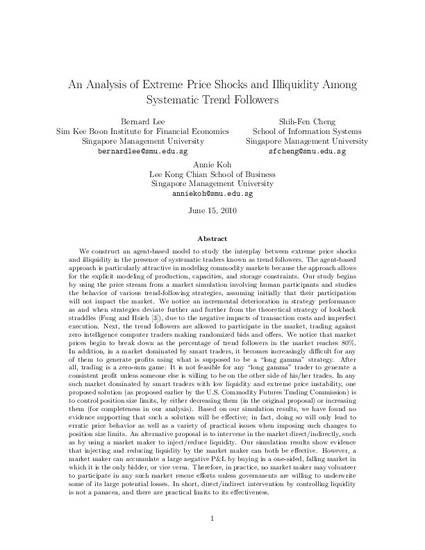
We construct an agent-based model to study the interplay between extreme price shocks and illiquidity in the presence of systematic traders known as trend followers. The agent-based approach is particularly attractive in modeling commodity markets because the approach allows for the explicit modeling of production, capacities, and storage constraints. Our study begins by using the price stream from a market simulation involving human participants and studies the behavior of various trend-following strategies, assuming initially that their participation will not impact the market. We notice an incremental deterioration in strategy performance as and when strategies deviate further and further from the theoretical strategy of lookback straddles (Fung and Hsieh 2001), due to the negative impacts of transaction cost and imperfect execution. Next, the trend followers are allowed to participate in the market, trading against "uninformed" computer traders making randomized bids and offers. We notice that market prices begin to break down as the percentage of trend followers in the market reaches 80%. In addition, in a market dominated by "smart traders," it becomes increasingly difficult for any of them to generate profits using what is supposed to be a "long gamma" strategy. After all, trading is a zero-sum game: It is not feasible for any "long gamma" trader to generate a consistent profit unless someone else is willing to be on the other side of his/her trades. In any such market dominated by "smart traders" with low liquidity and extreme price instability, one proposed solution (as proposed earlier by the U.S. Commodity Futures Trading Commission) is to control position size limits, by either decreasing them (in the original proposal) or increasing them (for completeness in our analysis). Based on our simulation results, we have found no evidence supporting that such a solution will be effective; in fact, doing so will only lead to erratic price behavior as well as a variety of practical issues when imposing such changes to position size limits. An alternative proposal is to intervene in the market direct/indirectly, such as by using a market maker to inject/reduce liquidity. Our simulation results show evidence that injecting and reducing liquidity by the market maker can both be effective. However, a market maker can accumulate a large negative P&L by buying in a one-sided, falling market in which it is the only bidder, or vice versa. Therefore, in practice, no market maker may volunteer to participate in any such "market rescue" efforts unless governments are willing to underwrite some of its large potential losses. In short, direct/indirect intervention by controlling liquidity is not a panacea, and there are practical limits to its effectiveness.
- Extreme Price Shocks,
- Market Liquidity,
- Systematic Trend Followers,
- Speculative Activities,
- Agent-Based Computational Economics,
- Commodity Trading Advisors,
- Financial Crisis
Available at: http://works.bepress.com/sfcheng/37/
